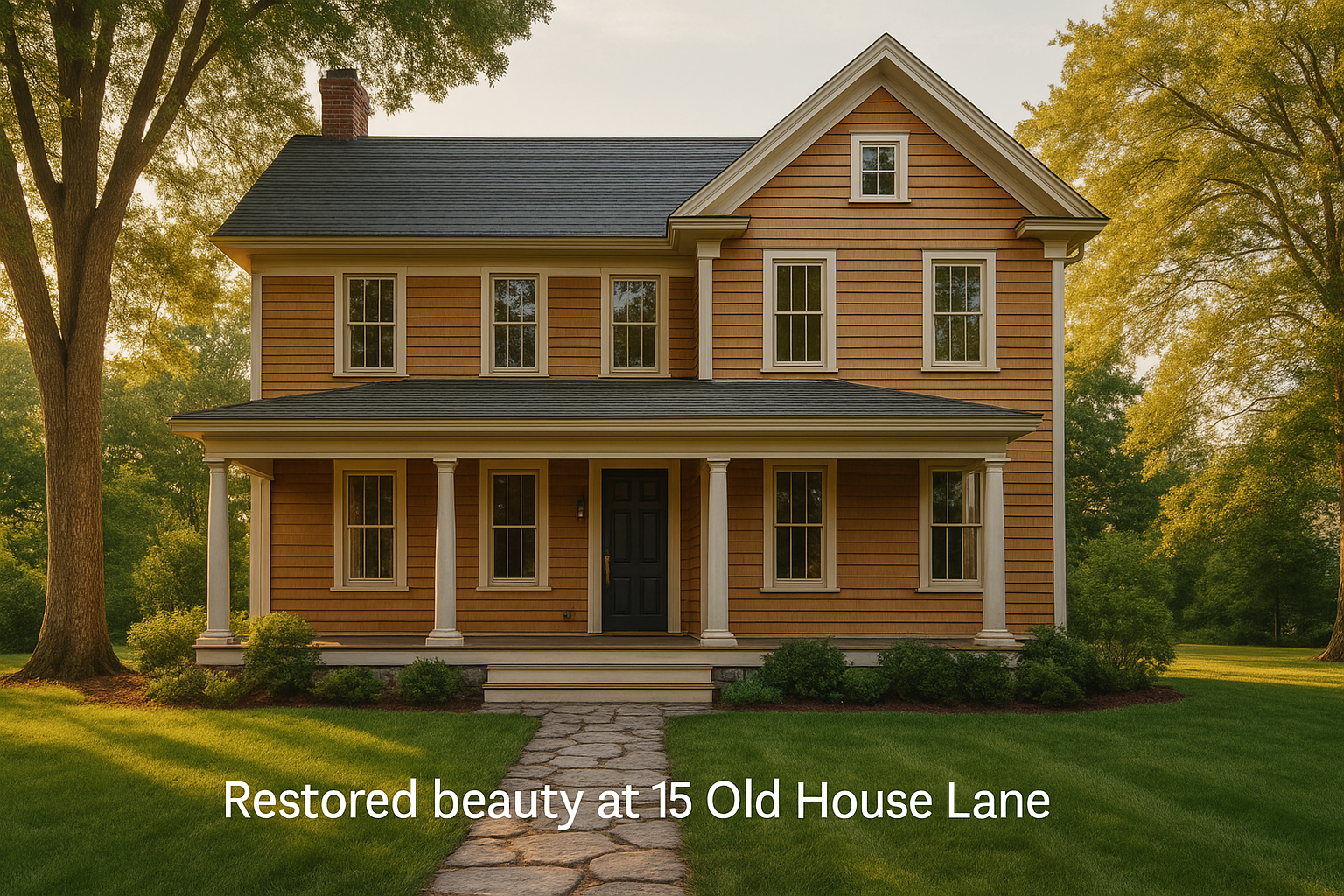Old houses hold a beauty that never fades. They stand as proof of time and tradition. Every brick, every wooden beam, and every corner tells a story. Walking into such a house feels like stepping back in time. The charm, the craft, and the detail create a warmth that modern homes often lack.
Owning one of these homes brings pride but also duty. Strong walls can hide weak points. Roofs may leak. Floors may sag. Old pipes may rust. Fixing such problems takes patience and care. Restoring an old home is not just about repairs. It is about keeping history alive while making the space safe and fit for life today.
This guide will take you through each step. You will learn how to inspect, plan, and restore with confidence. We will cover structure, design, and cost. We will also share ways to blend modern comfort with classic style.
Let us walk through the journey of bringing a house like “15 Old House Lane” back to its full beauty.
Understanding the Value of Old Homes
Old homes are more than walls and roofs. They represent craft that modern builders often rush past. Many carry thick stone, strong beams, or handmade bricks. These materials last longer than many used today. They also add detail that no factory copy can replace.
Living in such a home builds pride. It creates a bond with history. The creak of a step, the cut of trim, or the curve of a railing speaks of a past era. Many owners feel less like buyers and more like caretakers. They know they hold something worth saving.
Old houses can also bring strong value. Buyers often pay more for features like stained glass, porches, and tall ceilings. Restoring such details can raise property worth. Whole neighborhoods see growth when historic homes receive care.
First Step: Inspect Before You Begin
Do not start work until you know what the house hides. Hire a licensed inspector. Ask them to check the roof, the foundation, plumbing, and electrical lines. Their report will show urgent risks and long-term needs.
Skipping this step leads to loss. A coat of paint means little if water drips behind the wall. A shiny floor will not last if the base sags. Old wires can turn into fire hazards. Early inspection protects you from hidden costs.
After the check, write two lists. First, urgent safety repairs like roof leaks, wiring faults, or cracked beams. Second, cosmetic updates like new paint, lights, or floors. This order keeps work safe and steady.
Building a Realistic Budget
Restoration costs more than most expect. Start with the inspection report. Add estimated costs to each repair. Include permits, labor, and supplies. Then add at least twenty percent as a safety net. Old houses always surprise you.
Decide what you can handle alone. Some jobs, like sanding wood or painting walls, save money if you do them. But never risk work on wiring, plumbing, or roofing if you lack skill. Hire experts where failure could harm safety.
Look into grants or tax breaks. Many states reward care for historic property. These programs can cut costs. Local housing offices often share advice on how to apply.
Respecting the Original Design
Each old house carries a unique design. Before you remove or replace, study it. Take photos of trim, stairs, or doors. Ask neighbors or local historians what they know.
Keep original parts when you can. Solid wood floors, heavy doors, or carved beams add rare character. Old glass and hardware may hold detail that new copies cannot match. If repair is not possible, replace with parts that respect the style.
Respecting design does not mean rejecting comfort. Add insulation. Upgrade wiring. Improve lighting. The goal is balance. The new should blend with the old, not erase it.
Roof and Foundation: Protect the Frame
The roof keeps the house safe. Inspect for leaks, broken shingles, or sag. Replace or repair quickly. Choose materials that match the age of the house. Slate, wood shakes, or clay tiles often suit older homes.
The foundation is the core. Check for cracks, damp spots, or tilted walls. If you find deep damage, call a structural engineer. Never ignore these problems. Fix them first, before any design work.
Walls, Windows, and Doors
Old homes often use plaster, not drywall. Plaster feels solid but can crack. Small cracks are easy to patch. Larger breaks may need skilled repair. Always check if dampness causes the damage. Wet plaster points to leaks.
Windows add charm but may waste heat. You can restore old frames and add storm windows. Or you can replace with efficient glass that copies the old look. Choose with care, since wrong replacements harm the home’s style.
Doors tell their own tale. Heavy wood doors often outlast modern ones. Strip, sand, and refinish instead of replacing. A polished old door can shine like new but still keep history.
Plumbing and Electrical
Pipes in old homes may rot. Lead pipes in very old homes are unsafe. Have a plumber check every line. Replace where needed. Good pipes protect the rest of the house.
Old electrical systems are risky. Knob-and-tube wiring or fuse boxes cannot handle today’s devices. Hire a licensed electrician. Upgrade to modern panels and safe wiring. This not only prevents fires but also makes your home ready for modern use.
Heating, Cooling, and Insulation
Old houses often lack insulation. Cold winds slip through walls. Summers turn hot without barriers. Add insulation in attics and walls. Pick materials that allow wood to breathe. Trapped moisture can rot beams.
Check heating systems. Old furnaces may be unsafe. Replace with modern, efficient models. Add cooling systems if needed. Central air is ideal, but in some homes, window units may work better. Comfort matters, but keep changes respectful of the design.
Kitchens and Bathrooms
Kitchens and baths test every restorer. They need modern plumbing yet must hold style.
In kitchens, keep original cabinets if solid wood. Sand, stain, or paint to refresh. Pick counters that fit the era. Stone or butcher block works well. Avoid flashy finishes that clash with old charm.
Bathrooms may need full rebuild. Old tubs, sinks, or tiles often carry beauty. Try to save them. Add modern touches where needed: safe plumbing, strong lights, and efficient showers. A mix of classic fixtures and modern comfort creates the best space.
Floors, Ceilings, and Trim
Check under carpets. Many old floors hide fine hardwood. Remove rugs and polish what you find. Repair scratches. Replace boards only if they cannot be saved. Match the wood type and style.
Ceilings often show cracks or stains. Fix leaks first. Then patch and paint. If beams or tiles decorate the ceiling, keep them. They add rare detail worth saving.
Trim, molding, and doors frame the style. Keep as much original as you can. If sections are lost, have copies made. Even small trims shape the story of the house.
Choosing Colors and Finishes
Color shapes mood. Old houses often used deep earth tones, soft greens, or muted shades. Study charts of historic paints. Pick shades close to the home’s era.
Finishes also matter. Use matte or eggshell paint for walls. Choose stains that show wood grain. Avoid cheap vinyl or shiny plastic. Simple, natural finishes last longer and look right in old homes.
Gardens and Outdoor Spaces
The home does not end at its walls. The yard builds its character. Search old photos of the property if possible. Let them guide your plan.
Wood fences, stone paths, and porches often suit these homes. Restore them instead of tearing them out. Plant trees or shrubs that fit the climate and style. Add lighting that feels soft and welcoming, not harsh.
Choosing Experts
You cannot do it all alone. Hire experts for structure, roofing, or wiring. Pick people who have worked on old houses before. Ask for proof and visit past projects.
Explain your goals clearly. Say you want the house safe but also true to its past. The right contractor will respect that balance.
Doing It Yourself
Some tasks are safe to handle on your own. Painting walls, planting gardens, or restoring small furniture can save money. They also create a bond between you and the house.
Always protect yourself. Wear masks when sanding old paint. Use gloves and goggles when working with tools. Never attempt plumbing or wiring without training.
Mistakes to Avoid
Many owners make the same errors. They rush into design before fixing structure. They replace when they could repair. They ignore budget limits. They lose patience and stop halfway.
Avoid these traps. Work in order: foundation, roof, systems, walls, then design. Repair what you can. Replace only when needed. Plan money with care. Above all, enjoy the process.
The Reward of Restoration
Restoring a house like “15 Old House Lane” brings more than beauty. It saves history. It gives life back to walls that may have stood silent for years. Families grow proud of the work. Neighbors admire it. Guests feel its warmth.
The work ties you to the past. It also builds a gift for the future. Your efforts today may protect the house for another hundred years. Each board, each nail, each detail carries your mark into history.
Frequently Asked Questions
What makes an old house worth restoring
An old house holds value when the structure stays strong. Features like thick wood floors, carved trim, and tall ceilings add lasting charm. These details are hard to find in new homes.
How can I tell if an old house is safe to buy?
A full home inspection gives answers. A trained expert checks the roof, pipes, wiring, and base. The report shows what needs fixing before you spend more.
Do restored homes need more upkeep?
Upkeep depends on the work done. If repairs are solid, the house runs smooth. If updates are rushed or skipped, problems grow. Good work keeps costs low.
What issues show up most in old homes?
Old homes often have leaks, worn roofs, or unsafe wires. Cracks in walls or loose bricks are signs of stress. Rusted pipes and weak drains are also common.
Can I add modern comfort without ruining the style?
Comfort fits if you plan well. You can add heat, cool air, and better lights. Use care to hide new work so the home keeps its look.
Is it cheaper to fix an old house than build new?
Some projects cost less, but deep damage can raise the price. A well-kept old home may still win in value. The charm and story it holds give it something new homes lack.
Conclusion
Restoring a classic home is not easy. It demands time, skill, and patience. Yet the reward is priceless. You protect history and create comfort. You build pride and leave a legacy.
The path is simple if you move step by step. Inspect first. Build a budget. Fix structure. Respect design. Add modern safety with care. Work with experts and do what you can. Avoid mistakes and enjoy the journey.
When the work ends, you will stand in front of more than a house. You will see a living story. You will feel history breathing through the walls. That is the true gift of restoring a classic home like “15 Old House Lane.
Some luxury homes mix historic charm with modern style, much like the design seen in Inside Jerry Jones House, where classic elements blend with upscale finishes.




